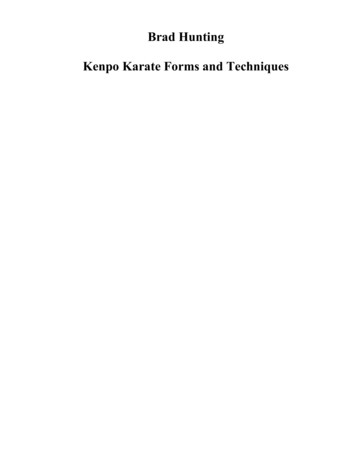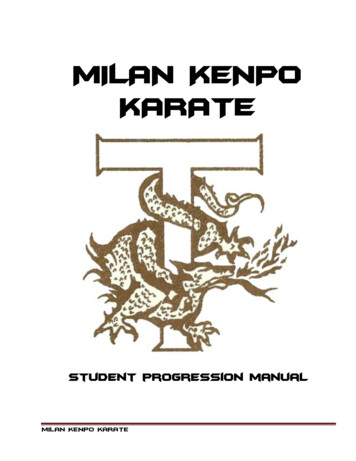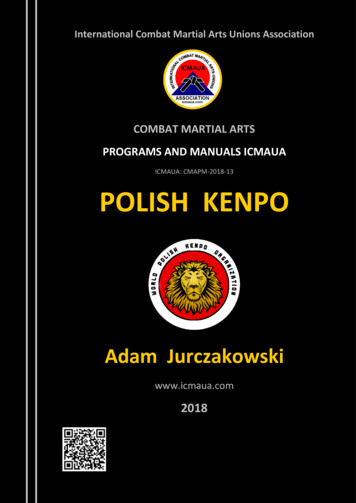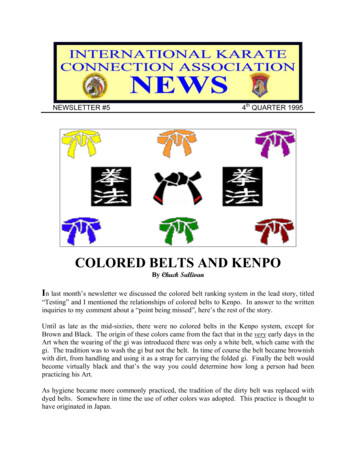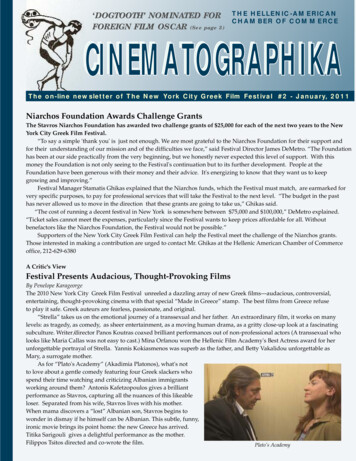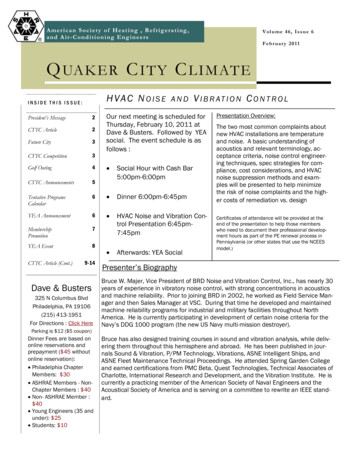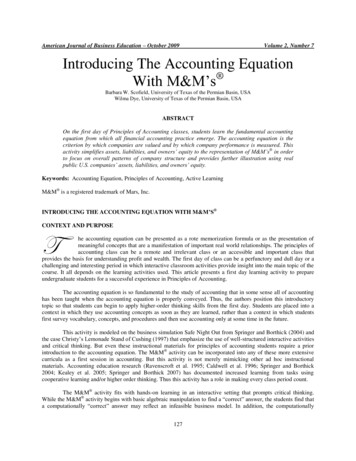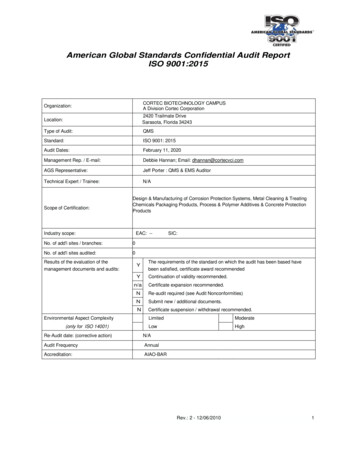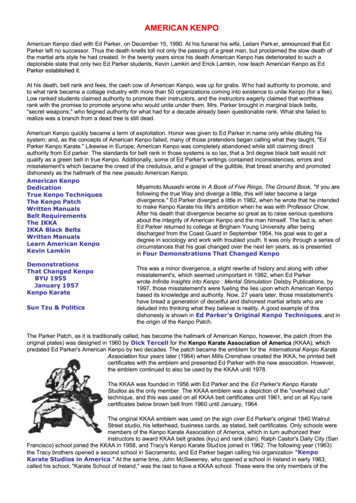
Transcription
AMERICAN KENPOAmerican Kenpo died with Ed Parker, on December 15, 1990. At his funeral his wife, Leilani Park er, announced that EdParker left no successor. Thus the death knells toll not only the passing of a great man, but proclaimed the slow death ofthe martial arts style he had created. In the twenty years since his death American Kenpo has deteriorated to such adeplorable state that only two Ed Parker students, Kevin Lamkin and Erick Lamkin, now teach American Kenpo as EdParker established it.At his death, belt rank and fees, the cash cow of American Kenpo, was up for grabs. W ho had authority to promote, andto what rank became a cottage industry with more than 50 organizations coming into existence to unite Kenpo (for a fee).Low ranked students claimed authority to promote their instructors, and the instructors eagerly claimed that worthlessrank with the promise to promote anyone who would unite under them. Mrs. Parker brought in marginal black belts,"secret weapons," who feigned authority for what had for a decade already been questionable rank. What she failed torealize was a branch from a dead tree is still dead.American Kenpo quickly became a term of exploitation. Honor was given to Ed Parker in name only while diluting hissystem; and, as the concepts of American Kenpo failed, many of those pretenders began calling what they taught, "EdParker Kenpo Karate." Likewise in Europe, American Kenpo was completely abandoned while still claiming directauthority from Ed parker. The standards for belt rank in those systems is so lax, that a 3rd degree black belt would notqualify as a green belt in true Kenpo. Additionally, some of Ed Parker's writings contained inconsistencies, errors andmisstatement's which became the creed of the credulous, and a gospel of the gullible, that bread anarchy and promoteddishonesty as the hallmark of the new pseudo American Kenpo.American KenpoMiyamoto Musashi wrote in A Book of Five Rings, The Ground Book, "If you areDedicationfollowing the true Way and diverge a little, this will later become a largeTrue Kenpo Techniquesdivergence." Ed Parker diverged a little in 1982, when he wrote that he intendedThe Kenpo Patchto make Kenpo Karate his life's ambition when he was with Professor Chow.Written ManualsAfterhis death that divergence became so great as to raise serious questionsBelt Requirementsabout the integrity of American Kenpo and the man himself. The fact is, whenThe IKKAEd Parker returned to college at Brigham Young University after beingIKKA Black Beltsdischarged from the Coast Guard in September 1954, his goal was to get aWritten Manualsdegree in sociology and work with troubled youth. It was only through a series ofLearn American Kenpocircumstances that his goal changed over the next ten years, as is presentedKevin Lamkinin Four Demonstrations That Changed KenpoDemonstrationsThat Changed KenpoBYU 1955January 1957Kenpo KarateSun Tzu & PoliticsThis was a minor divergence, a slight rewrite of history and along with othermisstatement's, which seemed unimportant in 1982, when Ed Parkerwrote Infinite Insights into Kenpo : Mental Stimulation Delsby Publications, by1997, those misstatement's were fueling the lies upon which American Kenpobased its knowledge and authority. Now, 27 years later, those misstatement'shave bread a generation of deceitful and dishonest martial artists who aredeluded into thinking what they believe is reality. A good example of thisdishonesty is shown in Ed Parker's Original Kenpo Techniques, and inthe origin of the Kenpo Patch.The Parker Patch, as it is traditionally called, has become the hallmark of American Kenpo, however, the patch (from theoriginal plates) was designed in 1960 by Dick Tercell for the Kenpo Karate Association of America (KKAA), whichpredated Ed Parker's American Kenpo by two decades. The patch became the emblem for the International Kenpo KarateAssociation four years later (1964) when Mills Crenshaw created the IKKA, he printed beltcertificates with the emblem and presented Ed Parker with the new association. However,the emblem continued to also be used by the KKAA until 1978.The KKAA was founded in 1956 with Ed Parker and the Ed Parker's Kenpo KarateStudios as the only member. The KKAA emblem was a depiction of the "overhead club"technique, and this was used on all KKAA belt certificates until 1961, and on all Kyu rankcertificates below brown belt from 1960 until January, 1964.The original KKAA emblem was used on the sign over Ed Parker's original 1840 WalnutStreet studio, his letterhead, business cards, as stated, belt certificates. Only schools weremembers of the Kenpo Karate Association of America, which in turn authorized theirinstructors to award KKAA belt grades (kyu) and rank (dan). Ralph Castor's Daily City (SanFrancisco) school joined the KKAA in 1958, and Tracy's Kenpo Karate Stud ios joined in 1962. The following year (1963)the Tracy brothers opened a second school in Sacramento, and Ed Parker began calling his organization " KenpoKarate Studios in America." At the same time, John McSweeney, who opened a school in Ireland in early 1963,called his school, "Karate School of Ireland," was the last to have a KKAA school. These were the only members of the
KKAA, and while Ed Parker had a promotion committee at his school, the head instructor of each KKAA school appointed"Authorized Members" to award belts and sign KKAA certificates. Students in the KKAA schools wore the Kenpo KarateFist Club Patch.The transition from the KKAA Emblem and the Club Patch began inJune 1960 when Ed Parker joined with Kung Fu master, James (Jimmy)Wing Woo, who began adding his Chinese style into Kenpo Karate.This association with Woo has led many in American Kenpo to claim EdParker trained in different Kung Fu styles and under some notable KungFu Masters, one of whom they claim was San Francisco Kung FuMaster, Lao Boon. It was, however, James Wing Woo who was withSan Francisco Kung Fu Master Lao Boon for over 20 years; and EdParker never trained with Lao Boon. Will Tracy had introduced EdParker to Lao Boon in early 1959 and the Kung Fu master was cordialand polite, and he and Ed Parker talked, but that was all. Ed Parkerreturned to San Francisco in December 1959 where Lao Boonintroduced him to several of his students. Then, in June 1960 some ofthose students, as well as James Wing Woo, came to visit Ed Parker.They stayed at Ed Parker's home on State Street while in Los Angeles,and Ed Parker asked Woo to stay. Ed Parker then trained with LaoBoon's student, James Wing Woo, but not with the master himself.In 1962, Will Tracy was at Lao Boon's school two or three night a week for nearly a year doing paper work of Master Lao.Lao did not teach non Chinese, but placed the desk so Will Tracy could observe the class each night as he worked. Lao,was furious with Ed Parker over how Parker had treated James Wing Woo, and Lao and Parker never met again after their1959 meeting. (The first non-Chinese to study with Lao Boon, was the actor Anthony (Tony) Quinn, whom Will Tracyintroduced to Master Boon in 1963.There is also the claim by those in AmericanKenpo that Ed Parker trained in Hung Gar. WillTracy, who was a close friend of Ed Parker for33 years trained with Seattle Hung Gar MasterJohn Leong. Will Tracy would demonstratesome of the Hung Gar forms for Ed Parker inthe 1980's. James Wing Woo had taught EdParker the Tiger and Crane form in 1960, and itwas a required black belt form at that time.However Ed Parker's later version omittedseveral moves and he went through the moves as though they wereKenpo, and not Hung Gar.During the entire time Will Tracy knew Ed Parker, Parker never once claimed to have trained with Lao Boon or to havetrained in Hung Gar, other than to learn the Tiger and Crane. Aditionally, Ed Parker did not know Moi Fa Kuen (thebeginning Hung Gar from) Lao Gar Kuen, which is the basis of Hung Gar, and is always taught in Hung Gar Training, orGung Gee Fuk Fu which always comes before Tiger and Crane; and Ed Parker had never seen Tiet Sin (Iron Thread MOre correctly Five Animals, Five Elements).It would seem reasonable that anyone in American Kenpo who claims Ed Parker trained in Hung Gar, would be able todemonstrate the Hung Gar forms. After all, if Ed Parker had deemed Hung Gar training important enough for him, then hewould have passed his training on to his American Kenpo students. This was certainly the way Ed Parker taught in 1960-61when he was associated with James Wing Woo, and the Kung Fu forms required back then were Tam Tui, 2 Man Tam Tui,Book Set, Tiger and Crane, 5 and 18 section punching set, and the Black Belt SetIt was Woo's influence that inspired Dick Tercell to design what would become the KKAA patch. This is more fullydocumented on kenpokarate.com. his The first KKAA black belt certificate that used the Tercell emblem wasawarded for Shodan beginning in January 1961.The most famous KKAA Shodan certificate is the January 7, 1962 Al Tracy Shodan Certificate. Some inAmerican Kenpo, including the actor Jeff Speakman have claimed that the Trac y brothers were only brown belts when theyleft Ed Parker. That is completely false. But truth for many in American Kenpo, is not what is true, but what they believe,even when confronted with the truth. Jim Tracy also received his Shodan on January 7, 1962 and left Ed Parker to openan Ed Parker School in San Francisco in April of 1962, while Al Tracy left later in May. Will Tracy was an Ed ParkerIkkyu when Ed Parker suggested he go to Hawaii to train under Professor Chow in 1959. Will Tracy returned as a Chow
KKAA, and while Ed Parker had a promotion committee at his school, the head instructor of each KKAA school appointed"Authorized Members" to award belts and sign KKAA certificates. Students in the KKAA schools wore the Kenpo KarateFist Club Patch.The transition from the KKAA Emblem and the Club Patch began inJune 1960 when Ed Parker joined with Kung Fu master, James (Jimmy)Wing Woo, who began adding his Chinese style into Kenpo Karate.This association with Woo has led many in American Kenpo to claim EdParker trained in different Kung Fu styles and under some notable KungFu Masters, one of whom they claim was San Francisco Kung FuMaster, Lao Boon. It was, however, James Wing Woo who was withSan Francisco Kung Fu Master Lao Boon for over 20 years; and EdParker never trained with Lao Boon. Will Tracy had introduced EdParker to Lao Boon in early 1959 and the Kung Fu master was cordialand polite, and he and Ed Parker talked, but that was all. Ed Parkerreturned to San Francisco in December 1959 where Lao Boonintroduced him to several of his students. Then, in June 1960 some ofthose students, as well as James Wing Woo, came to visit Ed Parker.They stayed at Ed Parker's home on State Street while in Los Angeles,and Ed Parker asked Woo to stay. Ed Parker then trained with LaoBoon's student, James Wing Woo, but not with the master himself.In 1962, Will Tracy was at Lao Boon's school two or three night a week for nearly a year doing paper work of Master Lao.Lao did not teach non Chinese, but placed the desk so Will Tracy could observe the class each night as he worked. Lao,was furious with Ed Parker over how Parker had treated James Wing Woo, and Lao and Parker never met again after their1959 meeting. (The first non-Chinese to study with Lao Boon, was the actor Anthony (Tony) Quinn, whom Will Tracyintroduced to Master Boon in 1963.There is also the claim by those in AmericanKenpo that Ed Parker trained in Hung Gar. WillTracy, who was a close friend of Ed Parker for33 years trained with Seattle Hung Gar MasterJohn Leong. Will Tracy would demonstratesome of the Hung Gar forms for Ed Parker inthe 1980's. James Wing Woo had taught EdParker the Tiger and Crane form in 1960, and itwas a required black belt form at that time.However Ed Parker's later version omittedseveral moves and he went through the moves as though they wereKenpo, and not Hung Gar.During the entire time Will Tracy knew Ed Parker, Parker never once claimed to have trained with Lao Boon or to havetrained in Hung Gar, other than to learn the Tiger and Crane. Aditionally, Ed Parker did not know Moi Fa Kuen (thebeginning Hung Gar from) Lao Gar Kuen, which is the basis of Hung Gar, and is always taught in Hung Gar Training, orGung Gee Fuk Fu which always comes before Tiger and Crane; and Ed Parker had never seen Tiet Sin (Iron Thread MOre correctly Five Animals, Five Elements).It would seem reasonable that anyone in American Kenpo who claims Ed Parker trained in Hung Gar, would be able todemonstrate the Hung Gar forms. After all, if Ed Parker had deemed Hung Gar training important enough for him, then hewould have passed his training on to his American Kenpo students. This was certainly the way Ed Parker taught in 1960-61when he was associated with James Wing Woo, and the Kung Fu forms required back then were Tam Tui, 2 Man Tam Tui,Book Set, Tiger and Crane, 5 and 18 section punching set, and the Black Belt SetIt was Woo's influence that inspired Dick Tercell to design what would become the KKAA patch. This is more fullydocumented on kenpokarate.com. his The first KKAA black belt certificate that used the Tercell emblem wasawarded for Shodan beginning in January 1961.The most famous KKAA Shodan certificate is the January 7, 1962 Al Tracy Shodan Certificate. Some inAmerican Kenpo, including the actor Jeff Speakman have claimed that the Trac y brothers were only brown belts when theyleft Ed Parker. That is completely false. But truth for many in American Kenpo, is not what is true, but what they believe,even when confronted with the truth. Jim Tracy also received his Shodan on January 7, 1962 and left Ed Parker to openan Ed Parker School in San Francisco in April of 1962, while Al Tracy left later in May. Will Tracy was an Ed ParkerIkkyu when Ed Parker suggested he go to Hawaii to train under Professor Chow in 1959. Will Tracy returned as a Chow
Shodan
American Kenpo Dedication True Kenpo Techniques The Kenpo Patch Written Manuals Belt Requirements The IKKA IKKA Black Belts Written Manuals Learn American Kenpo Kevin Lamkin Demonstrations That Changed Kenpo BYU 1955 January 1957 Kenpo Karate Sun Tzu & Politics Miyamoto Musashi wrote in A Book of Five Rings, The Ground Book, "If you are following the true
